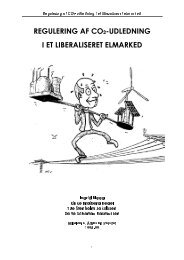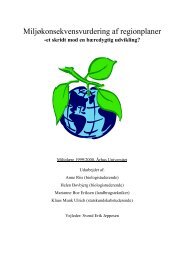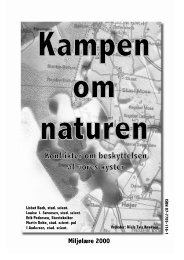University of Aarhus ECOTOURISM AS A WAY TO PROTECT ...
University of Aarhus ECOTOURISM AS A WAY TO PROTECT ...
University of Aarhus ECOTOURISM AS A WAY TO PROTECT ...
Create successful ePaper yourself
Turn your PDF publications into a flip-book with our unique Google optimized e-Paper software.
Ecotourism as a sustainable way to protect nature<br />
the more active cheetahs hours, the tourists are more active too, and since cars<br />
are allowed in some national parks, these animals have developed a stressrelated<br />
disease similar to HIV “…which causes their immune systems to<br />
collapse “(Kock, 1994). However, it has been shown that sometimes the<br />
presence <strong>of</strong> tourists can be positive for hunters due to the prey can be confused<br />
which; the tourists actually help the predator to in their hunting efforts.<br />
However, this is just a positive and marginal point <strong>of</strong> view if we consider that<br />
the cheetahs population has decreased 30 per cent since cars were allowed in<br />
national parks.<br />
A very important problem <strong>of</strong> the tourists presence is not only that animals<br />
get shy, on the contrary some <strong>of</strong> them get too used to humans (and their<br />
machines). They are used to be feed by them and some gets aggressive in order<br />
to get more food. A curious case is that <strong>of</strong> the Antarctic whales where “….calves<br />
normally maintain constant body contact with their mothers but, when separated,<br />
can transfer their attachment to the side <strong>of</strong> a boat” (Roe, 1997).<br />
In parks with species similar to human beings such as gorillas, human can<br />
contribute to infection <strong>of</strong> human diseases which are in some cases mortal. This<br />
has resulted in a minimum distance <strong>of</strong> 5 meters between gorillas and humans,<br />
although these rules sometimes are not fulfilled. (Roe, 1997).<br />
The basic indirect problem caused by the protection <strong>of</strong> National Parks is<br />
the change in habitats from trampling and littering. Managers in several National<br />
Parks worldwide consider forbidding cars in the parks because they (as for<br />
example, in the Kakadu National Park, Nothern Australia) “…contribute to<br />
weed infestation by transporting seeds into the park” (Roe, 1997). Littering is<br />
also a very important problem in National Parks nowadays. To avoid habitat<br />
changes, KNP “has a management policy that aims to retain the habitat in a state<br />
that is neither too closed for tourist viewing, nor too utilised by elephants” (Roe,<br />
65
















